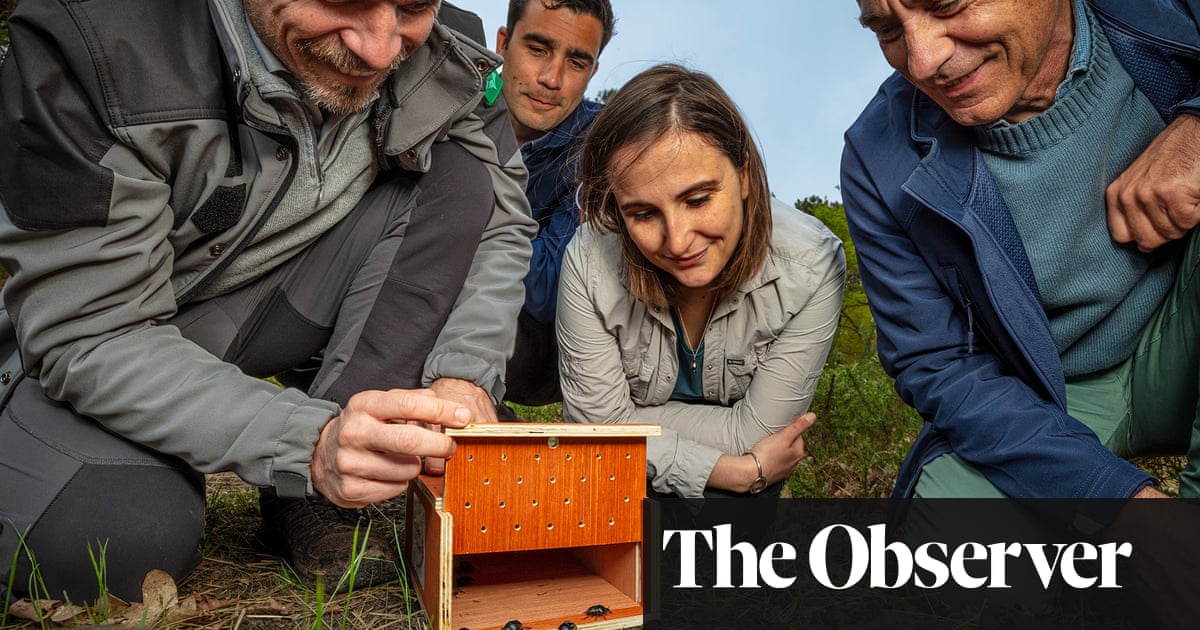
In a forest clearing filled with cowpats, French history is being made: the country’s first translocation of dung beetles in a nature reserve near Bordeaux.
With the same pomp and ceremony afforded to the release of an Iberian lynx or a European bison, about 60 “ball rolling” insects were brought to the marshy forests of Étang de Cousseau in south-west France on Wednesday to restore a vital ecosystem function on the Atlantic coast.
The dung beetles (scarabaeus laticollis) will feast on the waste produced by dozens of wild cattle that roam the dunes, moors and marshes of the rewilding project, recycling nutrients into the soil.
The insects disappeared from the region in the 1960s as the feral cattle population declined. The last herd of free-roaming marine landaise breed was saved from the slaughterhouse by conservationists in the late 1980s. Before the creation of vast pine plantations under Napoléon III, this area of Gascony was famous for its pastoralism, and shepherds would tend to their flocks on 5ft wooden stilts, with dung beetles thriving on the waste.
Now, along with the wild cattle, the dung beetles are back, released in a field freshly prepared with cowpats for their arrival.
“The dung beetle population all over the world has suffered a great decrease since the intensification of agriculture. Cattle and other domestic animals have been highly treated by farmers. The anti-worm and anti-parasite treatments leak into the waste and there’s been a huge decrease in dung beetles,” said Christelle Charlaix, an assistant warden at Étang de Cousseau nature reserve.
“Here, we have been working with a local breed of cows to manage the land. We do not treat them with drugs. Even though the cows have parasites, they are part of the cycle of life, they’re part of the biodiversity. Now, with the dung beetle project, the idea is to actually give a chance to this huge family of insects to come back.”
There are more than 5,000 species of dung beetle and they are found on every continent apart from Antarctica. Not all of them are “rollers”, which shape the dung into a ball and roll it to where they want to bury it in the ground. Some dig tunnels in the dung, some steal balls from the rollers, while others dwell on top of the waste. They are considered a keystone species because of their role in decomposition and seed dispersal.
The release of this batch of scarabaeus laticollis, brought from Montpellier in the south of France, was funded by Rewilding Europe’s European wildlife comeback fund, which has also supported projects reintroducing lynx in Poland, Bonelli’s eagles in Sardinia and water voles in Cornwall.
Mammals, especially large carnivores, often dominate reintroductions, but conservationists say plants and wildlife must be brought back at every level of the ecosystem for it to be truly restored.
“There is beautiful biodiversity in the cowpats. In a microhabitat like that, it is full of life,” said Sophie Beaujean, an ecology masters student at Bordeaux University, whose job it is to check the piles of waste for beetles for a university project to monitor the success of the reintroduction.
Each dung beetle, released in two phases, is cleaned and a green dot drawn on its back in marker pen for identification. This species lives for a maximum of two years, laying its larvae in balls of dung.
A pair was spotted mating almost immediately after being released, the first sign that the dung beetles will reestablish themselves in Étang de Cousseau.
“Ah, la classique,” one observer noted of the reproduction technique.
The wider landscape at Étang de Cousseau is filled with birds moving along the East Atlantic Flyway on the parts of the wetlands that remain: spoonbills feed in the marshes on their way to breeding grounds farther north, lapwings can be heard calling, and a chorus of frogs in pools of water is a constant, with the Atlantic waves crashing in the background.
For François Sargos, who has helped manage the nature reserve since 1988, the rewilding project is personal. His own family is split between those that wish to see the pine forest removed in this part of Gascony to restore the wetlands and those involved in the lumber industry.
Sargos helped raise money to save the feral cows and has carefully cleared the nature reserve of pine trees, restoring the landscape to how it used to be, and was delighted with the return of the dung beetles. He is inspired by Gascon poet Félix Arnaudin, who was disgusted by the spread of pine plantations in the 19th century and documented the shepherds on stilts.
“He was seen as an eccentric but he was ahead of his time. You might say I am like Félix,” Sargos says, laughing. “He wrote very eloquently: ‘These pines are like the bars of a jail cell blocking the horizon.’ I really align with this.
“In the future, a much larger area would be the ideal for the reserve, where nature can do its own things with as little intervention as possible. A place where nature has been let go to fix man’s mistakes.”












